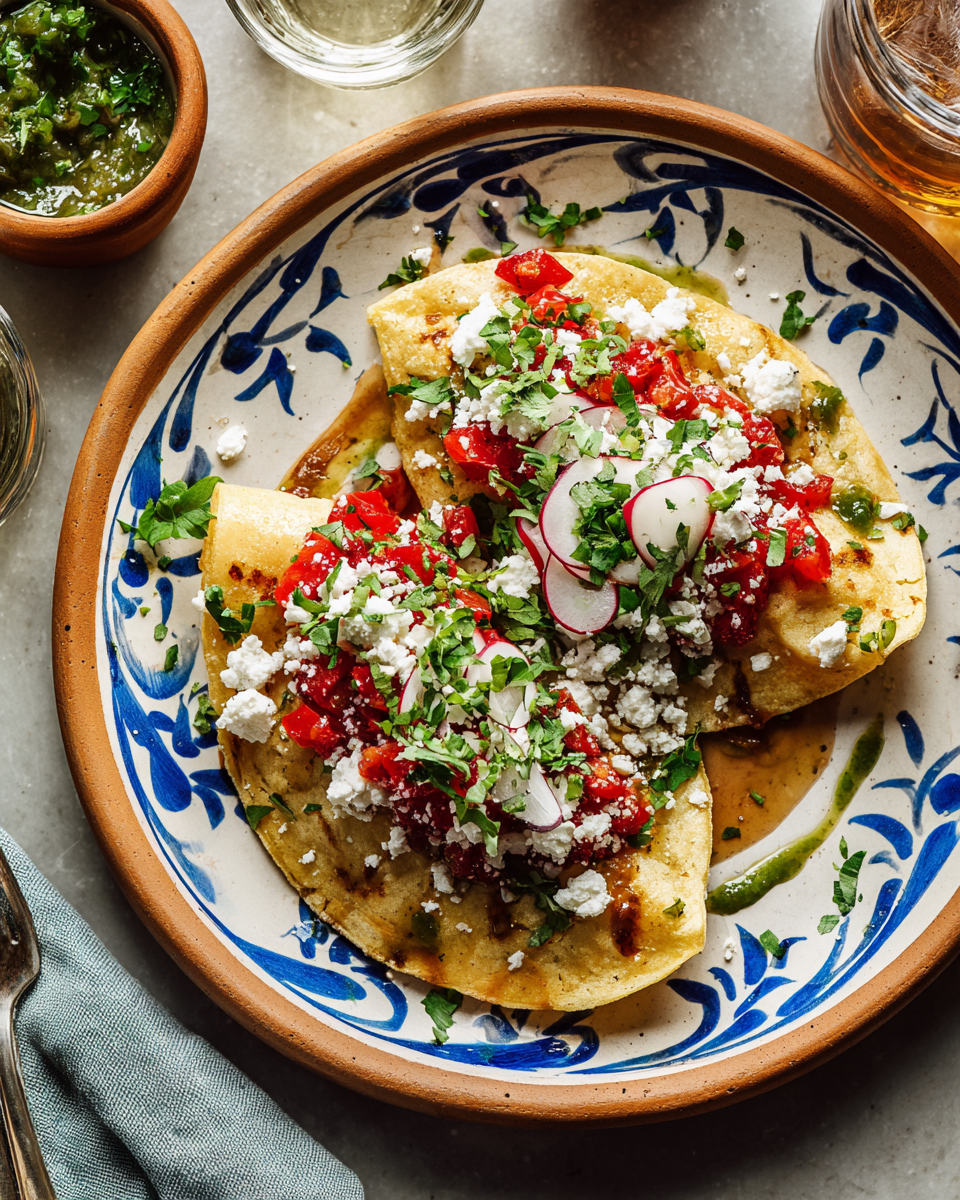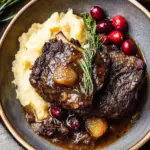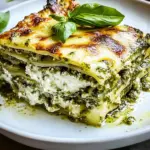The Tlacoyo is a deeply rooted Mexican street food staple, cherished for its chewy masa exterior and rich, savory bean or cheese filling. Traditionally cooked on a comal, these hand-formed ovals are topped with bright garnishes like cactus, cilantro, and salsa, making every bite both comforting and fresh.
Making tlacoyos at home is a labor of love—but well worth it. With patience, some masa, and a few humble ingredients, you can recreate this Mexico City street delicacy. The best part? They’re incredibly customizable. Whether you use black beans, pinto, or go full cheese, each tlacoyo is a bite of nostalgia and tradition, right from your skillet.
Full recipe:
Ingredients:
-
1 teaspoon lard (or neutral oil)
-
¼ small onion (plus more, chopped, for garnish)
-
1 garlic clove, peeled
-
16 oz cooked beans (or 1 can, liquid reserved)
-
Salt, to taste
-
1 lb fresh tortilla masa (or 1½ cups masa harina)
-
1 to 1½ cups warm water (for rehydrating masa harina)
-
1 (15 oz) jar pickled cactus strips or 4 fresh cactus paddles, diced and blanched
-
Chopped fresh cilantro
-
Crumbled queso fresco
-
Salsa of choice
Directions:
-
In a skillet over medium heat, heat lard and sauté the onion wedge and garlic until golden and blistered.
-
Add beans and mash roughly with a heatproof cup. The texture should be coarse (martajada). Add reserved bean liquid if needed and cook for about 5 minutes. Salt to taste.
-
If using masa harina, mix with 1 cup warm water and knead for 5 minutes. Add more water as needed until dough is very soft and pliable. For fresh masa, sprinkle with water and knead to a soft, creamy consistency.
-
Form golf ball-sized portions of masa and flatten into ¼-inch disks with your palm or tortilla press (don’t make it too thin).
-
Add 1–2 tablespoons of bean filling or requesón to the center of the disk. Shape into a long oval and fold the sides in to seal the filling.
-
Gently press the seams and shape into an elongated oval (tlacoyo shape). Set aside on a tray.
-
Heat a comal or nonstick skillet over medium heat. Cook the tlacoyos dry (no oil), flipping until both sides are freckled and crisp (10–12 minutes).
-
Garnish with cactus, chopped onion, cilantro, queso fresco, and your favorite salsa. Serve warm.
Prep Time: 20 minutes | Cooking Time: 12 minutes | Total Time: 32 minutes
Kcal: 260 kcal | Servings: 6 tlacoyos
Cultural Significance
Beyond their culinary appeal, tlacoyos hold deep cultural and symbolic importance. They are often prepared and sold in local markets and street corners, particularly during festivals or family gatherings. In many indigenous communities, the making of tlacoyos is passed down through generations, with mothers teaching daughters the delicate craft of kneading masa and shaping it by hand. The act of preparing tlacoyos is often communal, a labor of love that brings families together. They also play a significant role in preserving indigenous identity and resistance, standing as a delicious testament to Mexico’s rich and complex cultural heritage.
Nutritional Value and Benefits
Tlacoyos are an inherently nutritious dish, especially when made with nixtamalized masa (corn dough treated with lime), which enhances the bioavailability of essential nutrients such as calcium and niacin. The use of beans as a filling provides plant-based protein, fiber, and important minerals like iron and magnesium. When paired with toppings like nopales (cactus), cilantro, onions, and salsa, tlacoyos become a well-rounded meal rich in vitamins, antioxidants, and anti-inflammatory properties. For those following vegetarian or even vegan diets (when omitting cheese), tlacoyos offer a satisfying and wholesome option that doesn’t compromise on flavor or tradition.
Modern-Day Popularity
Although rooted in history, tlacoyos have gained renewed popularity in recent years, both in Mexico and abroad. Food lovers and chefs are rediscovering the beauty of traditional, handmade dishes and incorporating them into modern culinary trends. In bustling urban areas like Mexico City, tlacoyos are a common sight in morning markets and street stalls, often served with freshly made salsa, crumbled cheese, and even toppings like crema or guacamole. In the United States and Europe, Mexican restaurants and food trucks have begun to introduce tlacoyos to international audiences, where they are appreciated for their hearty nature and bold, earthy flavors.
What makes tlacoyos particularly attractive in contemporary cuisine is their versatility. They can be adapted to suit various dietary preferences and ingredient availability. From black beans and cheese to more adventurous fillings like huitlacoche (corn fungus) or mashed lentils, tlacoyos are the perfect blank canvas for flavor experimentation while staying true to their cultural roots.
The Art of Masa
At the heart of any good tlacoyo lies the masa. Masa, made from ground nixtamalized corn, is more than just a vehicle for fillings—it’s a foundational element that defines the texture, flavor, and authenticity of the dish. Working with masa requires a bit of intuition and a lot of care. It should be soft and pliable, not dry or sticky. Shaping the tlacoyos is also an art: the dough must be pressed just right to hold the filling without tearing and then gently formed into an elongated oval before being cooked on a hot comal. The reward is a slightly crispy exterior and a soft, almost creamy interior that envelopes the flavorful filling inside.
Using fresh masa yields the best results, but if it’s not available, masa harina (corn flour) can be rehydrated with warm water to create a comparable dough. Regardless of the source, the quality of masa can make or break a tlacoyo. It’s what gives the dish its toasty corn aroma and rustic charm.
Toppings and Garnishes
One of the joys of tlacoyos is how they are served. After being cooked until speckled and crisp on the outside, they are typically topped with ingredients that add brightness, texture, and depth of flavor. Common toppings include nopales (prickly pear cactus), which are lightly pickled or sautéed, giving the dish a tangy and vegetal counterpoint. Chopped white onions and fresh cilantro add crunch and freshness, while crumbled queso fresco lends a salty, creamy finish. Salsa, whether red, green, or smoky with chipotle, ties all the components together with a punch of heat and acidity.
While the toppings can vary, they always serve to complement the earthy, slightly sweet flavor of the masa and the creamy, seasoned filling inside. The tlacoyo is a balanced dish not just in its ingredients, but in its flavor profile—comforting, robust, and vibrant all at once.
Street Food Experience at Home
Recreating the tlacoyo experience at home is not only rewarding but also a great way to connect with Mexican culinary traditions. It brings a bit of the street food magic into your kitchen and offers an authentic taste of Mexico that goes beyond tacos and burritos. While tlacoyos may look deceptively simple, the process of making them from scratch encourages mindfulness and appreciation for the ingredients.
Because they are best served warm right off the comal, tlacoyos make a wonderful meal to share. Whether it’s a casual family dinner or a themed food night, preparing tlacoyos together can be a fun and educational activity. Kids and adults alike enjoy the process of shaping the masa, mashing the beans, and adding their favorite toppings. It’s also an opportunity to explore and respect a culture through food—a lesson in heritage and hospitality.
Variations Across Regions
While central Mexico is considered the heartland of tlacoyos, different regions have added their own flair to the dish. In Puebla, tlacoyos are often made thinner and served with pipián (a pumpkin seed sauce). In Hidalgo, they might be stuffed with chicharrón (crispy pork skin) or alverjón (yellow pea puree). Some areas even use blue corn masa, which lends a beautiful, distinctive color and deeper corn flavor. These regional differences reflect the diversity of Mexican cuisine and how each community adapts traditional dishes to reflect local tastes and available resources.
Even within families, recipes and techniques are passed down and personalized, making tlacoyos not just a dish, but a living legacy. Some might prefer a softer, steamed tlacoyo, while others cook them until slightly charred. Some love an extra-spicy salsa; others keep it mild with creamy avocado. This inherent adaptability is one of the reasons tlacoyos remain beloved across generations and geographies.
Conclusion
Tlacoyos are more than just food—they are a celebration of culture, history, and community. Their ancient roots, simple yet wholesome ingredients, and deeply satisfying flavor make them a standout in both traditional and modern Mexican cuisine. Whether you’re enjoying them on a street corner in Mexico City or crafting them from scratch in your own kitchen, tlacoyos offer a taste of authenticity that’s hard to match.
Making tlacoyos is a tactile, soulful process that invites you to slow down, get your hands in the dough, and appreciate the journey from masa to meal. It’s a dish that feeds both body and spirit, reminding us that the most meaningful foods are often the humblest. With every bite, tlacoyos carry the stories of the people who’ve made them for centuries—and now, with this recipe, you become part of that story too.






